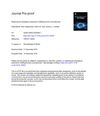Relating Neurosteroid Modulation of Inhibitory Neurotransmission to Behavior
September 2021
in “
Journal of Neuroendocrinology
”
neurosteroids progesterone deoxycorticosterone GABAA receptor positive allosteric modulators anxiolytic anticonvulsant analgesic sedative general anesthesia allopregnanolone brexanolone postpartum depression δ-GABAA receptor psychiatric disorders GABA receptor PAMs anxiety relief pain relief sedation anesthesia Zulresso depression
TLDR Neurosteroids can influence behavior by modulating brain inhibition, with potential for treating psychiatric disorders.
Studies from the 1980s identified endogenous metabolites of progesterone and deoxycorticosterone as potent positive allosteric modulators (PAMs) of the GABAA receptor, suggesting that neurosteroids can fine-tune neural inhibition in the CNS to influence behavior. Preclinical studies showed these neurosteroids have anxiolytic, anticonvulsant, analgesic, and sedative properties, and at high doses, they can induce general anesthesia. Despite challenges in realizing their therapeutic potential, the FDA's recent approval of allopregnanolone (brexanolone) for postpartum depression has renewed interest in their medicinal use. Neurosteroids are selective for GABAA Rs but not for its subtypes, though δ-GABAA Rs seem crucial for their behavioral effects. The paper explores the influence of neurosteroids on neuronal signaling and behavior, advocating for the development of selective PAMs of δ-GABAA R subtypes for psychiatric disorder treatments.





